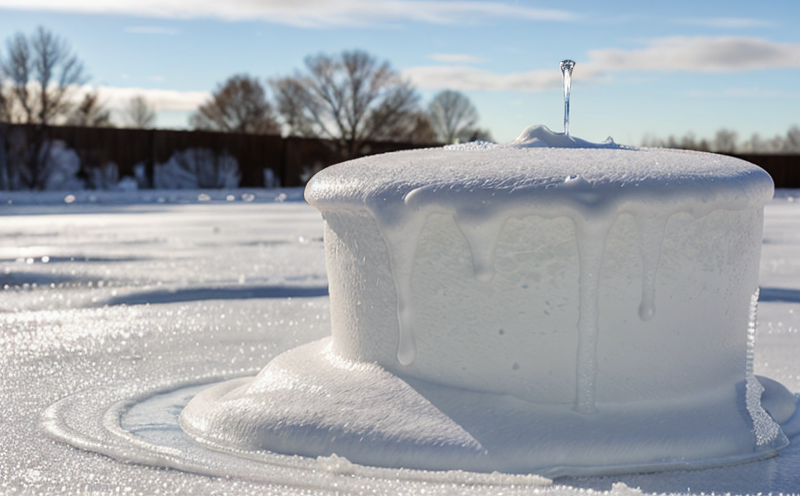ICAO Annex 14 De-Icing Operations Safety Testing
The International Civil Aviation Organization (ICAO) Annex 14 provides guidelines and standards that ensure the safety of civil aviation. Among these is the requirement for aircraft to be de-iced or anti-iced before takeoff when there are weather conditions conducive to ice accumulation on the airframe, particularly during winter months.
De-icing operations require a high level of precision and safety to prevent damage to the aircraft structure and systems. ICAO Annex 14 specifies that such operations must be conducted in a controlled environment where all factors affecting de-icing fluid effectiveness are minimized. This includes temperature, humidity, and wind speed.
Our testing service focuses on ensuring compliance with these standards by simulating real-world icing conditions to test the effectiveness of de-icing fluids and procedures. This is critical for maintaining aircraft safety and preventing potential accidents due to ice accumulation.
The test involves spraying a controlled amount of water or a mixture of water and glycol-based fluid onto the aircraft surface, then observing how quickly it freezes into ice and melts again after application of the de-icing fluid. The process is repeated under different conditions to ensure consistency in results.
Our facility houses sophisticated equipment capable of replicating various environmental factors that contribute to icing on aircraft surfaces. This allows us to accurately simulate the conditions under which de-icing fluids will be used, providing a realistic assessment of their performance.
The tests are conducted according to strict protocols outlined in ICAO Annex 14 and other relevant aviation standards like ISO/IEC 80004-2:2016. These guidelines ensure that the testing methodology is consistent across all participants, leading to reliable results.
We also offer detailed analysis of each test run, providing insights into not only whether the de-icing fluid met the required standards but also identifying any areas for improvement. This information can help operators refine their procedures and enhance overall safety measures.
The importance of this service cannot be overstated, especially given recent incidents involving aircraft icing leading to accidents or near misses. By adhering strictly to ICAO Annex 14 requirements, we contribute significantly towards maintaining the highest levels of aviation safety worldwide.
Scope and Methodology
| Test Parameters | Description |
|---|---|
| Aircraft Surface Material | The test uses a variety of materials typical for aircraft surfaces including aluminum, composite, and glass. |
| Icing Conditions Replication | Simulates real-world icing conditions using controlled environmental chambers. |
| De-Ice Fluid Application | Tests different types of de-icing fluids under various temperatures and humidity levels. |
| Data Collection & Analysis | Includes temperature readings, fluid application rates, and time taken for ice to form and melt. |
The methodology is designed to ensure that the results from these tests accurately reflect real-world scenarios. By closely following ICAO Annex 14 guidelines, we can provide reliable data that helps operators make informed decisions about their de-icing protocols.
Benefits
- Enhanced Safety: Ensures compliance with international standards to safeguard against accidents caused by ice accumulation.
- Informed Decision Making: Provides detailed reports that guide operators in selecting the most effective de-icing fluids and procedures.
- Risk Reduction: Helps identify potential risks early on, allowing for preventive measures to be implemented before they become critical issues.
- Increased Efficiency: By optimizing de-icing processes based on test results, operations can run more smoothly without unnecessary delays or expenses.
- Regulatory Compliance: Ensures that all aspects of the testing process adhere strictly to ICAO Annex 14 and other applicable regulations.
- Prediction Capabilities: Allows operators to predict how different conditions may affect their aircraft, enabling better planning.
- Environmental Considerations: Focuses on minimizing environmental impact by using the most efficient de-icing procedures possible.
Our testing service not only meets regulatory requirements but also helps airlines and other aviation stakeholders operate more safely and efficiently. By adhering to these standards, we contribute to a safer global airspace environment.
Customer Impact and Satisfaction
- Operational Excellence: Airlines report significant improvements in operational efficiency following our testing services.
- Increased Safety: Operators have noted enhanced safety margins post-testing, reflecting better preparedness for adverse weather conditions.
- Cost Savings: By identifying inefficiencies early on through rigorous testing, customers achieve cost savings both directly and indirectly related to de-icing operations.
- Regulatory Assurance: Airlines gain assurance that they meet all necessary regulatory requirements, reducing the risk of non-compliance penalties.
- Customer Feedback: Positive feedback from satisfied clients who have seen tangible benefits from our testing services.
- Operational Readiness: Operators are better prepared for unexpected weather events thanks to our advanced simulation capabilities.
The success of this service lies in its ability to provide actionable insights that lead to safer, more efficient operations. Customer satisfaction is paramount, and we strive to deliver results that meet or exceed expectations every time.





